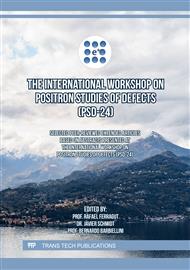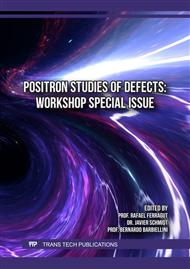[1]
B. Wilson, A. Miloshevski, D. Hooper and N. Peters, Radiation-Induced Dark Counts for Silicon Single-Photon Detectors in Space, Phys. Rev. Appl. 16 (2021) 064049–064061.
DOI: 10.1103/physrevapplied.16.064049
Google Scholar
[2]
J. Logan, K. Woller, P. Webster, C. Morath, M. Short, Open volume defect accumulation with irradiation in GaN, GaP, InAs, InP, Si, ZnO, and MgO, J. Appl. Phys. 134 (2023) 225701–225725.
DOI: 10.1063/5.0147324
Google Scholar
[3]
T. Sekiguchi, M. Steger, K. Saeedi, M. L. W. Thewalt, H. Riemann, N. V. Abrosimov and N. Nötzel, Hyperfine structure and nuclear hyperpolarization observed in the bound exciton luminescence of Bi donors in natural Si, Phys. Rev. Lett. 104 (2010)137402–137406.
DOI: 10.1103/physrevlett.104.137402
Google Scholar
[4]
H. Riemann, N. Abrosimov, N. Nötzel, Doping of silicon crystals with Bi and other volatile elements by the pedestal growth technique, ECS Trans., 3 (2006) 53–55.
DOI: 10.1149/1.2355745
Google Scholar
[5]
P. Becker, H.-J. Pohl, H. Riemann, N. Abrosimov, Enrichment of silicon for a better kilogram, Phys. Stat. Sol. A, 207 (2010) 49–66.
DOI: 10.1002/pssa.200925148
Google Scholar
[6]
V. V. Emtsev, A. M. Ivanov, V. V. Kozlovski, A. A. Lebedev, G. A. Oganesyan, N .B. Strokan, G. Wagner, Similarities and distinctions of defect production by fast electron and proton irradiation: moderatly doped silicon and silicon carbide of n-type, Fiz. Tekh. Poluprov. 46 (2012) 473–481.
DOI: 10.1134/s1063782612040069
Google Scholar
[7]
N. Yu. Arutyunov, M. Elsayed, R. Krause-Rehberg, V.V. Emtsev, G.A. Oganesyan, V.V. Kozlovski, Positron annihilation on defects in silicon irradiated with 15 MeV protons, J. Phys.: Condens. Matter 25 (2013) 035801–035828.
DOI: 10.1088/0953-8984/25/3/035801
Google Scholar
[8]
E. Boronski, R. Nieminen, Electron-positron density-functional theory, Phys. Rev.B 34 (1986) 3820 –3831.
DOI: 10.1103/physrevb.34.3820
Google Scholar
[9]
J. Li, N. H. Le, K. L. Litvinenko, et al., Radii of Rydberg states of isolated silicon donors, Phys. Rev. B 98 (2018) 085423-1–085431-8.
Google Scholar
[10]
C. Bussolati, A. Dupasquier, L. Zappa, Positron bound states in alkali halides, Nuovo Cimento B 52 (1967) 529–538.
DOI: 10.1007/bf02711095
Google Scholar
[11]
L. Simons, The Existence of Positronium Chloride, Phys. Rev. 90 (1953) 165–166.
DOI: 10.1103/physrev.90.165
Google Scholar
[12]
G. Wolfowicz, A. M. Tyryshkin, R. E. George, H. Riemann, N. V. Abrosimov, P. Becker, H.-J. Pohl, M. L. W. Thewalt, S. A. Lyon, J. J. L. Morton, Atomic clock transitions in silicon-based spin qubits, Nature Nanotechnology 8 (2013)561–564.
DOI: 10.1038/nnano.2013.117
Google Scholar
[13]
N. Arutyunov, R. Krause-Rehberg, M. Elsayed, V. Emtsev, N. Abrosimov, G. Oganesyan, V. Kozlovski, Microstructure of bismuth centers in silicon before and after irradiation with 15 MeV protons, J. Phys. Condens.Matter 33 (2021) 245702–245717.
DOI: 10.1088/1361-648x/abe96f
Google Scholar
[14]
H. Höhler, N. Atodiresei, K. Schroeder, R. Zeller, P. H. Dederichs, Vacancy complexes with oversized impurities in Si and Ge, Phys. Rev. B 71 (2005) 035212–035219.
DOI: 10.1103/physrevb.71.035212
Google Scholar
[15]
D. V. Makhov, L. J. Lewis, Stable fourfold configurations for small vacancy clusters in silicon from ab initio calculations, Phys. Rev. Lett. 92 (2004) 255504–255508.
DOI: 10.1103/physrevlett.92.255504
Google Scholar
[16]
T. E. M. Staab, A. Sieck, M. Haugk, M. J. Puska, Th. Frauenheim, H. S. Leipner, Stability of large vacancy clusters in silicon, Phys. Rev. B 65 (2002)115210–115221.
DOI: 10.1103/physrevb.65.115210
Google Scholar
[17]
G. D. Watkins, Defects in irradiated silicon: EPR of the tin-vacancy pair, Phys. Rev.B 12 (1975) 4383-4390.
DOI: 10.1103/physrevb.12.4383
Google Scholar
[18]
S. Bubin, L. Adamowicz, Nonrelativistic variational calculations of the positronium molecule and the positronium hydride, Phys. Rev. A 74 (2006) 052502-1–052502-5.
DOI: 10.1103/physreva.74.052502
Google Scholar



